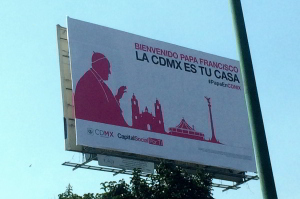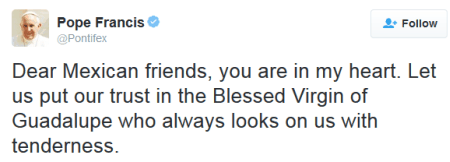Pope Francis Visits Mexico
Yesterday, Pope Francis arrived in Mexico City. He’ll spend the weekend here before heading to the State of Chiapas on Monday morning, the State of Michoacán on Tuesday morning, and finally the state of Chihuahua, in the border city of Ciudad Juárez.
In spite of the hundreds of thousands flocking to see him, there certainly are mixed feeling about the visit of the Pope, even among Roman Catholics.
Billboards like this one welcome him officially (“Welcome, Pope Francis – the CDMX (City of Mexico) is Your Home”). Other billboards pray that he will bring peace and hope to the country. Many people hope that the coming of the Pope will finally bring change to the country.
Others are more skeptical. Some are urging the Pope to “talk tough” against corruption, human rights violations and violence. Some are just frustrated by all the road closures in the city, which started even before he arrived. Some are outraged at the money being spent on the visit, while so many live in poverty. Some even complain that the events will lead to the further spread of the Zika virus.
But many downtown workers are just glad for a day off work due to a closed road.
Watching the Pope’s video messages to Mexico, it’s obvious that he has something else on his mind. What is it exactly that Francis wants out of his visit?
The majority of the videos I watched had one theme – the Virgin of Guadalupe. He wants to stand before her, and look into her eyes. When he feels her presence, he hears the words – do not be afraid – am I not here, who am your mother?.
Francis is actually referring to an image of what is believed by many Mexicans to be a manifestation of the Virgin Mary. Deflecting the trust and hope that many people have in him, Francis points to his source of hope in this tweet:
 Many of my Christian friends want to remind everyone that our hope should not be in a man, or in an image of the Virgin, but in Jesus.
Many of my Christian friends want to remind everyone that our hope should not be in a man, or in an image of the Virgin, but in Jesus.
While the news sources wait for the Pope’s speeches and hang on every word, he himself is looking forward to his moments to stand before the image in veneration. He will also be performing masses in various locations, including in Mexico City this afternoon.
Many people don’t realize that the mass is absolutely central to the Roman Catholic view of salvation. The mass is a sacrifice, where the priest (in this case, the Pope), is an “Altus Christus” (“another Christ”), with the power to bring Christ down and offer the sacrifice for the people.
The bread and wine are Christ. Many times when you hear Roman Catholic missionaries speak of “bringing Christ to the people”, you’ll find that they’re actually talking about bringing the sacrifice of the mass – because the food is Christ, and to take the mass is to be justified.
Hence the bread and wine are literally worshipped. The lay people don’t drink the wine, because if a little of it spilled, it would be “Jesus” spilling.
For salvation, repeatedly going to mass is necessary.
In a sense, the mass and other sacraments are a system in which the RC Church doles out salvation little by little. For many in Mexico, whatever the official teaching may be, this becomes a bit of an economic system. This blessing, this mass, this visit to the image or the Pope – that gives me credit to get away with a little more, to go to the party, to get forgiveness.
The Bible teaches in the book of Hebrews that the repetitive nature of the Old Testament sacrifices were, in the end, just a reminder of sin (Hebrews 10:3). They looked forward to something much more complete. The “once for all” sacrifice of Christ removed sin forever (Hebrews 9:25-26), bringing true peace with God – not a peace given a little at a time, or a peace that is temporary and uncertain. A peace that is based on what Jesus has already done (Romans 5:1-2; 1Corinthians 1:30-31).
Some look for hope in the Pope, or the mass, or the Virgin of Guadalupe. Others look to politics and protests. But there is still – and will always be – only one Hope (Hebrews 10:15-23).
